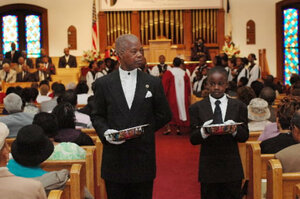Tithing, church giving dips; sign of the economy or value of charity?
Tithing and church giving in general has taken the most prolonged dip since the Great Depression. Is the economy to blame or perhaps a failure to teach that tithing and giving is an integral part of the spiritual life?

Church giving has taken the most prolonged decline since the Great Depression. Here, ushers David Brian (l.) and Alex Mayhem collect the offering at the Peoples Baptist Church in Boston.
John Nordell/The Christian Science Monitor, File
The collection plate. The tithing. The special envelope. The Sunday school teacher stipend. The funds for the new heater, new roof, and new hymnals. The missions. The seminarians. The refugees. The homeless shelter, the cash for the hard-luck case who knocks on the parsonage door, the electric bill for the newly unemployed. Your church can, if nothing else, find you good ways to spend your money. But tithing and other forms of church giving are down of late – a victim, experts say, of the decline in church attendance, the economy, and, some say, a failure to teach that giving is an integral part of the spiritual life.
According to the Religion News Service, Open Tomb, a Christian research and service organization, reported last month that for 2011, the most recent data available, church giving was down for the fourth year in a row, to 2.3 percent of a member’s annual income, from 2.4 percent the year before. It was the first such prolonged decline since the Great Depression. Some 100,000 U.S. mainline, evangelical, and unaffiliated Protestant congregations were studied, and though Catholics weren’t included, previous data indicate their giving to be comparable, or slightly less, than the others. The drop affected not so much the local congregations, as the “benevolences,” mission, and ministries outside the local church.
How do believers approach that great question of “stewardship,” or, more plainly for today’s purposes, “money”? Matt Branaugh, of Christianity Today’s Church Law and Tax Group, sees giving theologically: “not a requirement, per se, but a response” to a loving God. In Christianity, at least, giving stems from and parallels the example of God, who sacrificed everything, including his son, for mankind. The believer, in turn, is moved to want to give back. The examples of this are all over scriptures: the poor widow who gave to the temple everything she had; the rich man condemned to hell for his years of ignoring the beggar Lazarus; the loathed tax collector Zacchaeus, who, affirmed by Jesus, was moved to give away half his fortune. And so on.
But today’s church headlines seem full of stories of fraud, scandal, and ineptitude. Then, too, professionalization of church fund-raising sometimes seems to manipulate the sacred in pursuit of the sell. Actual incidence of fraud and embezzlement within congregations is “very, very small,” says Branaugh, and can be averted through complete transparency, where the church books are open, the budget handled correctly, the planned ministries and activities are actually taking place. If you don’t see that, it’s cause for considering another congregation. For non-local contributions to the poor, the Evangelical Council for Financial Accountability accredits church charities worldwide. [Editor's note: An earlier version of this story incorrectly identified the Evangelical Council for Financial Accountability.]
Speaking of the poor, how rich should your church be? How much cash ought conscience allow for things like stained glass, parking lot landscaping, and support staff? Some see property holdings of any kind as unnecessary wealth. Yet church architecture – be it Quaker austerity or cathedral splendor – traditionally has provided not just shelter for prayer but also a vehicle for directing human creativity for the honor of God. And critics of church holdings may not realize, says Branaugh, that the nation’s churches are a charity in and of themselves, given over – at little or no cost – to a weekly whirl of Girl Scouts and 12-step programs, elder exercise classes and such, serving as de facto community centers.
Each family’s giving decisions will differ, and the answer to “how much” is a matter for prayer, experts say. Some people tithe – give a tenth of their annual income. Some do more than that and some not as much. But in the big picture, giving is less a matter of dollar amount than of heart. No matter how seemingly insignificant the gift, “we’re acting as a matter of faith that God is going to show up and do something with that,” says Branaugh.

